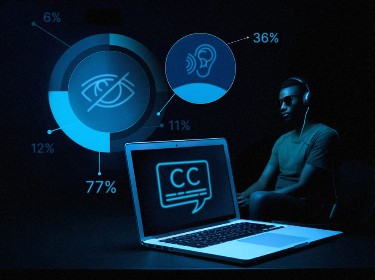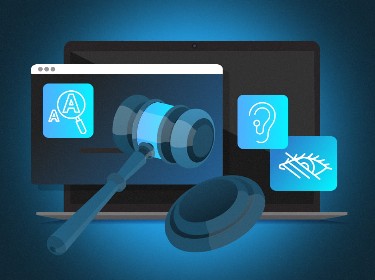Section 508 of the US Rehabilitation Act protects the rights of disabled individuals in obtaining state & federal services using information and communication technology. With regard to online services, it points to the web content accessibility guidelines as a reference on how to achieve compliance.
Federal and local government bodies are entitled to provide equal opportunities for the disabled regardless of their intellectual capability, and any physical or mental impairment. Section 508 was introduced as an amendment to the US Rehabilitation Act, which prohibited discrimination against the disabled. It stipulated that all federal agencies and their contractors must ensure the accessibility of electronic devices and software, including websites, apps, online services, and any digital content.
Our web accessibility consulting company prepared a detailed guide on this regulation, whether or not you fall within its jurisdiction, and how to ensure your adherence to the laws regarding web accessibility.
History of Section 508
The US Rehabilitation Act of 1973 (Rehab Act) is a federal law that prohibits discrimination of disabled individuals in all organizations that receive federal funding. It was one of the first laws that legally recognized disabled individuals as a minority group deserving of equal rights. This law required all federal agencies and federal programs to provide equal opportunities to people with disabilities based on their capabilities.
As technology progressed, so did the laws. The Rehabilitation Act was amended by the US Congress to address the evolving technological needs of people with impairments. Section 508 was added to the Rehabilitation Act In 1986. However, at that time there were no binding guidelines and standards. Section 508 was later modified in 1998 to cover a broader scope of technologies. Another recent update to Section 508 was made in 2017, keeping in view the innovations in technology like cell phones, web and online apps, etc.
The Access Board was created in 1973 as an independent federal agency to facilitate equal access for people with disabilities by defining accessibility standards and guidelines. Specific design criteria were then defined by the Access Board for brick and mortar buildings, facilities such as transit vehicles, telecommunications hardware, etc.
After Section 508 was passed, the board continued its mission to develop and maintain standards for accessible Information and Communications Technology (ICT) products. It defines what is Section 508 compliance and provides information on related accessibility regulations. These regulations, together with the additional guidelines and standards compiled by the board, serve as a framework for defining web accessibility and Section 508 compliance.
Why comply with Section 508?
According to the CDC, one in every four individuals living in the US has some sort of disability. People with disabilities, therefore, constitute a large group of the U.S. population. An estimated total of 61 million disabled adults in the U.S. includes the visually impaired, deaf or hard of hearing individuals, people with cognitive disorders, and the people who have limited mobility due to disease or trauma.
![]()
The law mandates that all federal agencies set an example of fair and just treatment of all individuals, regardless of them having a disability, by providing reasonable accommodations in public places. These accommodations include special ramp access, curb cuts, priority parking spaces, braille signs, tactile paving, etc. Just as the physical accommodations are important to be provided in all public places, accessibility features are essential for digital products and services as well.
Section 508 compliance ensures that users with disabilities get equal access to websites, online services, and digital content maintained by federal bodies. The Section 508 guidelines address the needs of various types of physical and mental impairments, requiring designers and developers of information technology products to embed special accessibility features.
Although Section 508 does not apply to private companies, digital and web accessibility have been acknowledged by a global community and is considered a legal obligation by federal courts. Website accessibility lawsuits are one of the main risks of non-adherence to accessible design standards. Check out our guide to ADA website lawsuits and how to avoid them for more details.
Who needs to comply with Section 508?
Section 508 applies to ICT products of all federal bodies, departments, and agencies. Federal employees and contractors developing digital content and websites have to make sure they adhere to Section 508 accessibility standards. While Section 508 does not apply to states or local governments, many states have established accessibility guidelines and principles in the same spirit as Section 508 standards.
A federal agency is exempt from compliance if implementing these standards poses an “undue burden” on that agency. In such a case, the agency has to justify its non-compliance. Section 508 exemptions also include systems relevant to national security, weaponry, military action, etc. These exemptions are, however, not applicable to routine administrative systems.
Everything you need to know about Section 508 compliance for websites
![]()
Section 508 guidelines are applicable to all of the federal government’s electronic and online information, resources, and content made available to the public as well as its own employees. The purpose of Section 508 legislation is to provide a framework for accessibility enabling the federal agencies to incorporate these features in ICT products.
Section 508 final rule
Section 508 final rule defines accessibility standards not only for websites but also for digital and electronic content and software. The legislation directly requires Web Content Accessibility Guidelines (WCAG 2.0) defined by the World Wide Web Consortium (W3C) to be followed with at least level AA compliance. The WCAG, now being the widely accepted international standard, is taken as the reference point against which accessibility is defined and measured.
Section 508 and the Web Content Accessibility Guidelines
The WCAG standard contains clear functional guidelines with a checklist of features needed to be implemented to provide full accessibility. These website design features include specifications on color and contrast, layouts, navigation methods, third party plugin integration, forms, textual and pictorial information, videos, etc.
In order to develop a Section 508 compliant website, an organization needs to follow WCAG guidelines for accessibility. Check out our full guide to web accessibility and ADA compliance to find more information on how to adhere to the global web standard.
Key features of Section 508 compliant website
![]()
A Section 508 compliant website is one that can be used, perceived, understood, and operated by people, despite an impairment related to vision, hearing, color perception, speech, cognition or motor skills, etc. This calls for a website design that caters to a wide audience by its accessible design.
For example:
- There should be various ways of navigating a website, including via keyboard, mouse, and assistive technologies.
- Magnification and zoom features should allow the visually impaired to enlarge and magnify various portions of the screen.
- Multimedia and images should be accompanied by text alternatives, captions, and transcripts.
- All third-party services used on the website must support assistive technologies such as screen readers.
- Digital content should be fully accessible from different browsers and devices.
It is a misconception that a Section 508 website design is primitive, unaesthetic, and not visually appealing. Adhering to Section 508 compliance requirements and the WCAG guidelines allows you to create a well structured and effective website with multi-modal interaction and robust functionality. It offers the same features and attractive UI while being accessible and convenient to use for a wider range of people.
Section 508 web compliance testing guidelines
The GSA Government-wide IT Accessibility Program provides comprehensive Section 508 web compliance testing guidelines and resources, which include valuable tools and recommendations for testing accessibility. Both manual and automated testing need to be applied for a complete accessibility check. The accessibility program suggests using Accessible Name and Description Inspector (ANDI) and Color Contrast Analyzer (CCA) for automated testing.
The automated tools can instantly check large volumes of data and content for compliance. However, they do not catch all violations. A manual audit is also required, however, it needs to be carried out by experts with an understanding of the technical side of Section 508 and its requirements.
Web development in conformance with Section 508
It is in the best interest of companies and organizations, whether private or public, to adopt accessibility standards as laid down by Section 508, WCAG, and ADA. While Section 508 does not apply to private businesses, they should develop accessible websites and online services to cater to the needs of a broad range of audiences with disabilities. Such websites have more page views, better statistics, and a wider set of users, leading to an increase in the consumer base.
Ultimately, website accessibility and WCAG conformance is a mandatory requirement for websites and online services. Turn to PixelPlex expert accessibility consultants for a comprehensive web accessibility audit. We’ll prepare your website for compliance with Section 508, the ADA, or the WCAG web standard.
Our accessible web development company offers a complete package of services, including web audit for WCAG violations, remediation of inaccessible features, or redesign of the website to ensure full conformance with accessibility standards.




